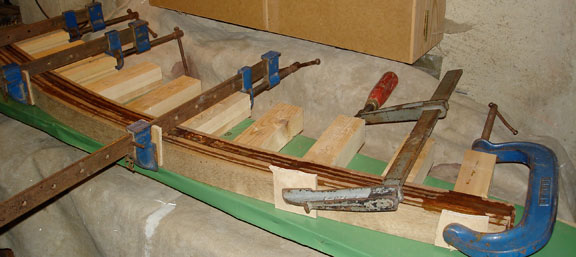This may be of interest to some of you. I've been looking around a bit as with decent progress on the workshop refurbishment i'm starting to eye its first project using the new kit - my Schwarz type Roubo bench.
Digging on epoxies I came across some good technical information on bonding wood with them - i'm thinking of using a slow epoxy to bond together the 20 or so 4x1 1/4in beech planks (on edge) which make up the top.
Despite intending to do it in groups of say four planks at a time I'm a bit wary of the relatively short 15 min open time you get with even Titebond Extend - I've never done a big glue up like this before. (thoughts anybody?)
Gurit is a well regarded supplier of epoxies and related composite construction materials. Some of you guys might have encountered their products before labelled as being by SP Systems - SP is a brand within their boat building products business so far as I know. http://www.gurit.com/
The document 'Guidelines on Bonding with Epoxy in Wood Construction':
http://www.gurit.com/downloads.asp?sect ... res&page=2 I know it's somewhat an infomercial, but it's got some interesting things to say about urea formaldehyde and resorcinol which seem to have some definite shortcomings.
There's actually a whole library of technical literature on the site about all sorts of epoxy and composite materials uses:
http://www.gurit.com/downloads.asp?sect ... +Brochures
PS Somebody claimed on a US woodworking site recently that laminations they had made with epoxy suffered from creep, which is very much against my (other) experience with the stuff. Lots of others came in to say otherwise, but it prompted me to take a look.
Keith over on the Woodwork forum has a thread up right now on some outdoors testing he's doing on various adhesives which may be of interest too.
There's more info of one sort or another on the West epoxies site: http://westsystem.com/ss/ UK sources: http://westsystem.com/ss/indealer-area. ... mit=Search
Digging on epoxies I came across some good technical information on bonding wood with them - i'm thinking of using a slow epoxy to bond together the 20 or so 4x1 1/4in beech planks (on edge) which make up the top.
Despite intending to do it in groups of say four planks at a time I'm a bit wary of the relatively short 15 min open time you get with even Titebond Extend - I've never done a big glue up like this before. (thoughts anybody?)
Gurit is a well regarded supplier of epoxies and related composite construction materials. Some of you guys might have encountered their products before labelled as being by SP Systems - SP is a brand within their boat building products business so far as I know. http://www.gurit.com/
The document 'Guidelines on Bonding with Epoxy in Wood Construction':
http://www.gurit.com/downloads.asp?sect ... res&page=2 I know it's somewhat an infomercial, but it's got some interesting things to say about urea formaldehyde and resorcinol which seem to have some definite shortcomings.
There's actually a whole library of technical literature on the site about all sorts of epoxy and composite materials uses:
http://www.gurit.com/downloads.asp?sect ... +Brochures
PS Somebody claimed on a US woodworking site recently that laminations they had made with epoxy suffered from creep, which is very much against my (other) experience with the stuff. Lots of others came in to say otherwise, but it prompted me to take a look.
Keith over on the Woodwork forum has a thread up right now on some outdoors testing he's doing on various adhesives which may be of interest too.
There's more info of one sort or another on the West epoxies site: http://westsystem.com/ss/ UK sources: http://westsystem.com/ss/indealer-area. ... mit=Search






